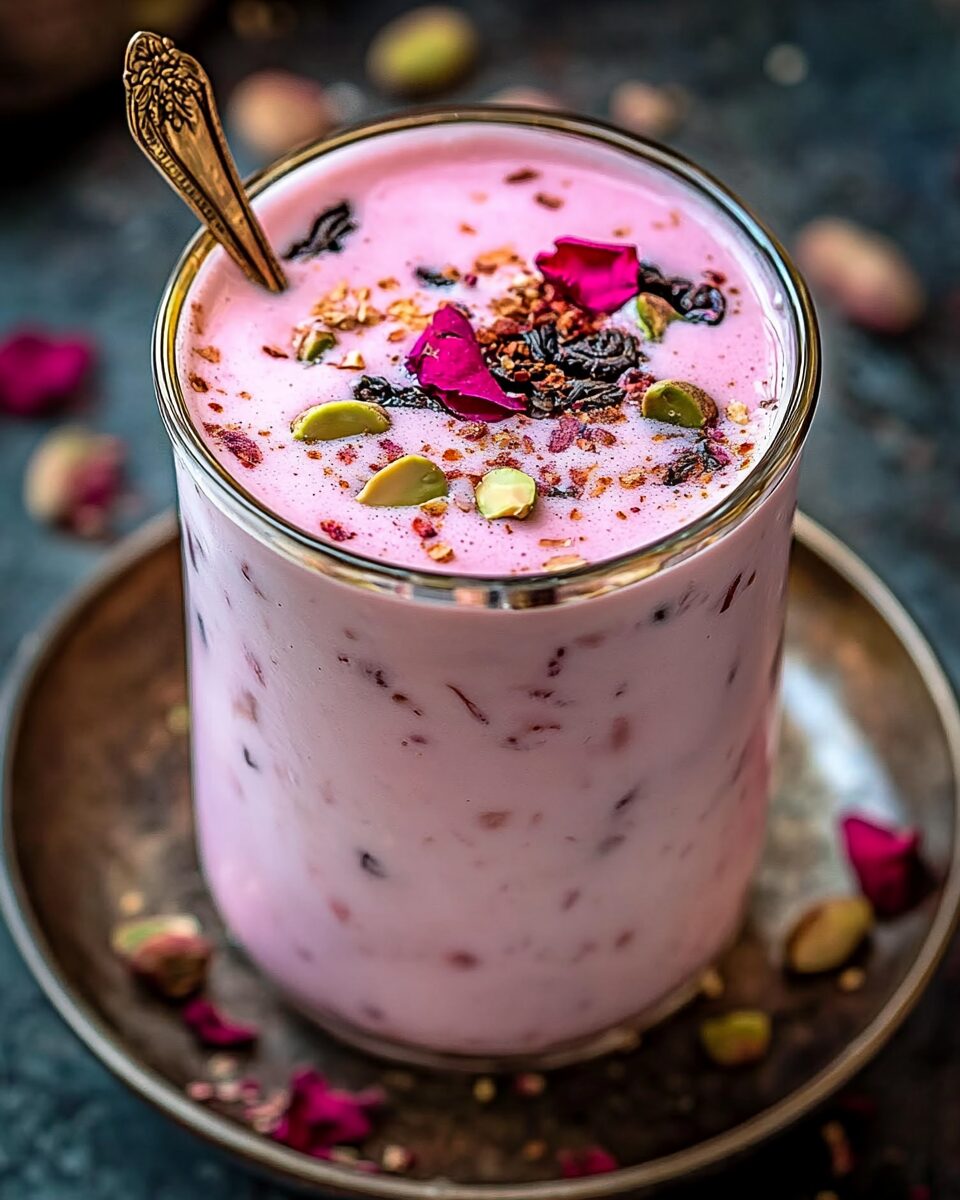The elegant and vibrant Kashmiri Pink Chai, also known as Noon Chai, is a treasured beverage from the Kashmir Valley. Unlike the typical sweet Indian chai, this version surprises the palate with a creamy, slightly salty taste and a beautiful blush-pink color achieved through a unique brewing method involving green tea leaves, baking soda, and milk. Traditionally sipped during winter or on festive occasions, this tea is often garnished with crushed nuts and rose petals for added indulgence. Its soothing warmth and rich texture make it not just a drink but an experience of comfort, heritage, and artistry in a cup.
Full Recipe:
Ingredients:
-
4 cups water
-
2 tablespoons Kashmiri green tea leaves
-
1/4 teaspoon baking soda
-
2 cups cold water (for shocking)
-
2 cups whole milk
-
1/2 cup heavy cream (optional for extra creaminess)
-
1/2 teaspoon ground cardamom
-
1/4 teaspoon ground cinnamon
-
Salt to taste (traditionally about 1/4 teaspoon)
-
2 tablespoons chopped pistachios (for garnish)
-
1 tablespoon chopped almonds (for garnish)
-
Crushed rose petals (optional, for garnish)
Directions:
-
In a saucepan, bring 4 cups of water to a boil. Add the Kashmiri green tea leaves and the baking soda.
-
Boil for 10-15 minutes, allowing the color to develop and deepen to a reddish hue. Stir vigorously during boiling to oxygenate the mixture.
-
Add 2 cups of cold water to the boiling mixture to shock it and help develop the signature pink color. Boil for another 5 minutes.
-
Reduce the heat and slowly add the milk (and heavy cream, if using). Stir continuously as the tea turns a soft pink color.
-
Add ground cardamom, cinnamon, and salt. Let it simmer for 5-7 minutes until well blended and slightly thickened.
-
Strain the tea into cups. Garnish with chopped pistachios, almonds, and rose petals if desired.
-
Serve hot and enjoy the delicate warmth of this traditional Himalayan beverage.
Prep Time: 10 minutes | Cooking Time: 25 minutes | Total Time: 35 minutes
Kcal: 210 kcal | Servings: 4 servings
Kashmiri Pink Chai (Noon Chai): A Sip of Himalayan Elegance
When we think of chai, most of us immediately imagine the milky, spiced masala chai commonly served across India. But travel north to the serene and snow-covered valleys of Kashmir, and you’ll discover a completely different kind of chai Noon Chai, also known as Kashmiri Pink Chai. With its blush-pink hue, velvety texture, and unique salty flavor, this traditional beverage is a soul-warming reflection of Kashmiri heritage and hospitality.
The Cultural Significance of Noon Chai
In Kashmiri households, Pink Chai isn’t just a drink it’s a ritual, often shared with friends and family during morning or evening conversations, especially in the cold winter months. It holds a strong cultural identity, symbolizing warmth, comfort, and tradition. Served with local breads like lavasa or kulcha, Noon Chai is part of the everyday rhythm of life in the valley.
Noon Chai literally translates to “salt tea,” a nod to one of its more surprising ingredients. The concept of salted tea may sound unusual to those unfamiliar with Himalayan or Central Asian cultures, but for Kashmiris, the slightly briny touch enhances the drink’s creaminess and provides a comforting depth of flavor. It’s a taste that has been passed down through generations, echoing centuries of shared stories, cold winters, and festive celebrations.
What Makes It Pink?
The magical pink color of Kashmiri Chai is not achieved with any artificial coloring or rose petals though those can be used as garnishes. Instead, it is the result of a complex chemical reaction between Kashmiri green tea leaves, baking soda, and the oxygenation process during brewing. When boiled vigorously, the green tea releases polyphenols (especially catechins), which, when reacting with the alkalinity of baking soda, transform from a deep amber-red into a stunning pink once milk is added.
This transformation is a key part of the recipe, and it’s why traditional preparation involves extended boiling, rapid whisking, and precise temperature control. There is a science to the beauty and it’s what gives Noon Chai its poetic appearance.
Flavor Profile: A Surprising Experience
The first sip of Kashmiri Pink Chai might surprise the uninitiated. It’s not sweet like most teas, nor heavily spiced like a masala chai. Instead, it’s:
-
Slightly salty, due to the inclusion of salt instead of sugar (though sugar versions now exist)
-
Mildly spiced, often with cardamom and sometimes cinnamon
-
Creamy and full-bodied, thanks to a generous use of milk and sometimes heavy cream
-
Nutty and aromatic, when garnished with crushed pistachios, almonds, or even rose petals
The end result is a rich, warming beverage that soothes the soul and stimulates the senses. It’s both indulgent and calming, making it perfect for quiet moments of reflection or shared winter afternoons.
A Winter Essential in Kashmir
Noon Chai is more than a flavorful drink it serves a functional purpose in Kashmir’s harsh winter climate. High in fat and served hot, it provides nourishment and warmth to withstand the cold. Traditionally consumed multiple times a day, especially during Harud (autumn) and Wandh (winter), it helps maintain body heat and acts as a mild appetite suppressant between meals.
The salt, a curious addition by global standards, also serves a physiological purpose. In high-altitude regions like Kashmir, salt helps the body retain fluids and maintain hydration, particularly important during dry, cold seasons.
Tips for Perfecting Pink Chai at Home
Recreating the exact taste and color of authentic Noon Chai can be tricky for first-timers. Here are some tried-and-true tips for mastering this tea:
-
Use authentic Kashmiri green tea leaves, also known as nun chai leaves or gunpowder tea. These are essential for the chemical reaction that turns the tea pink.
-
Don’t skip the baking soda. This is the catalyst that triggers the transformation of the tea’s color.
-
Whisk while boiling to ensure ample oxygen is introduced. This encourages the reddish hue to develop.
-
Add cold water mid-way through the brewing process. This sudden temperature drop also assists in creating the pink base.
-
Use full-fat milk or cream for the best consistency and flavor.
-
Strain and garnish generously. Crushed pistachios, almonds, and even edible rose petals enhance both the visual and flavor profile.
Variations Across Regions
While the traditional recipe is beloved, many families have developed their own interpretations of Kashmiri Pink Chai. Some common variations include:
-
Sweeter versions: To appeal to a broader audience or modern tastes, sugar or honey is sometimes added.
-
Masala-infused Noon Chai: Some add extra spices like fennel, cloves, or even a touch of saffron for depth.
-
Vegan Pink Chai: Plant-based milks such as almond, oat, or coconut can be used, though the texture and color may vary slightly.
-
Cold Pink Chai Latte: A modern, trendy twist served chilled over ice with frothy milk for a café-style presentation.
Each variation maintains the spirit of the original while allowing for personal or dietary preferences.
Kashmiri Chai in Pop Culture & Diaspora
As awareness of global cuisines grows, Kashmiri Pink Chai has made its way onto menus in cafes across the world from London to Toronto to Sydney. In the age of social media, its Instagram-worthy pastel tones and luxury garnishes have made it a favorite among food bloggers and tea connoisseurs.
For members of the Kashmiri diaspora, Noon Chai is more than a drink it’s a memory, a connection to home, and an expression of identity. Sharing Pink Chai at community gatherings or family dinners keeps traditions alive and introduces new generations to the charm of Himalayan flavors.
Serving Suggestions
Noon Chai is typically served in small cups, sometimes accompanied by local breads such as:
-
Lavasa – A thin, soft flatbread used for dipping
-
Kulcha – A crumbly biscuit-style bread, great for absorbing the tea
-
Sheermal – A saffron-flavored milk bread for those who prefer a sweet pairing
The tea is best enjoyed slowly, ideally in good company and under a warm blanket, making it as much about the experience as the taste.
Conclusion:
Kashmiri Pink Chai is a beautiful example of how tradition, science, and culture can come together in a single cup. Its rosy hue and creamy consistency are a visual delight, but it’s the taste a complex blend of salt, spice, and richness that truly sets it apart.
Whether you’re sipping it on a snowy afternoon, sharing it with loved ones, or simply exploring the world’s teas, Noon Chai offers a luxurious and authentic experience from the heart of the Himalayas.

